Soil and Airtemperature
Palm trees prefer best in a soil that is well drained and of a loamy, sandy nature. Depending on the type of soil in which your palm tree is planted, you may need to add in additional soil components to ensure your palm tree is getting the best drainage possible. In general, palm trees prefer air temperatures between 40 and 78 degrees Fahrenheit (4 and 26 degrees Celsius). They also do not do well in frost, so if you live in an area that has significantly cold winters, be sure to prepare your palm tree for any drastic temperature changes.
Sunlight
Your palm tree will thrive in direct sunlight, meaning your tree may need sun exposure anywhere between 6-12 hours of the day in order to grow properly. Make sure to research your type of palm tree to determine the ideal amount of sun needed to keep it healthy and growing.
Watering
It can be tricky finding the right watering schedule for your palm tree, but below are some general tips for ensuring your tree is receiving the right amount of water. First, consider the location you planted your tree in. Is your tree placed in a sunny spot or in the shade? The more sun your tree gets, the more water it will need each month. For example, if your tree is in direct sunlight, as previously mentioned, you should water it every 5-7 days. If your palm tree is in a spot that is partially covered by shade or clouds, it will need to be watered less often so make sure to adjust accordingly.
Another important factor is the type of soil your palm tree is in. If your palm tree’s soil is sandy, it will retain less water than a tree in a clay soil. Monitor your soil before and after you water it; if the soil retains moisture quickly, you don’t need to water as often. On the other hand, if it dries up quickly, you may need to water more.
Water amount
It is best to avoid giving your palm tree too much water, as this can lead to over-watering and waterlogging. To avoid this, only water your tree when the soil is just barely dry. When applying water, be sure to go slowly and give the soil plenty of time to absorb the water. When you water your palm tree, make sure to provide the soil with a deep soaking; you want to give the roots plenty of water but not enough to make the soil soggy.
When to Water
Typically, the best time to water your palm tree is early in the morning when the air is cool. This will enable the tree to take in the most water possible. Make sure to also check the weather conditions. If your tree is located in a spot that receives a lot of rain, no additional irrigation may be needed. In cases where there is not a lot of rain and the leaves of your tree start to look wilted, you may need to increase the water and frequency of your tree.
Container Type
When it comes to selecting the type of container for your palm tree, it’s important to choose one that won’t dry out too quickly, as this can lead to significantly less water retention. Choose a material that holds in moisture,such as, clay or terracotta.
Fertilizing
If you want your palm tree to thrive and reach an optimal level of health, it is important to provide the tree with adequate nutrients. Palm trees should be fertilized twice a year, once in the late winter/early spring months, and again in early summer. Make sure to select the right type of fertilizer for your individual tree, as not all types of fertilizer will give the best results. Always follow the instructions on the fertilizer label to ensure that you are applying it correctly.
Monitoring and Maintenance
In addition to the tips previously mentioned, it is important for you to monitor your palm tree’s growth and any damage it may be suffering. Check the tree’s roots, leaves, and trunk regularly to ensure they are healthy and keeping the tree well hydrated. Make sure that no weeds are growing around the base of the tree, as they could suck up as much water and moisture as the tree needs. Lastly, if you notice that your tree is not growing or is suffering any signs of distress, contact a professional palm tree arborist for help.
Protecting Trees From Discard Water and Runoff
Discarded or unused water, such as that found in garden sprinklers and fountains, can foster the growth of water-borne diseases that can be very harmful for palm trees. Being very sensitive to water-borne bacteria, you should collect and discard any standing water from around the tree and its roots. Runoff that may be contaminated with herbicides, pesticides, and chemicals must also be prevented from reaching the roots of your tree. To protect against this, consider putting down mulch around the tree to absorb any of the potentially harmful runoff and chemicals.
Alternative Watering Methods
More innovative watering techniques have been developed in recent years in order to help conserve water while still keeping your palm tree thriving. These methods include using recycled greywater, rainwater collection systems, and using a drip system to water your tree rather than using a sprinkler or hose. By using these types of water conservation methods, you can reduce the amount of water you use on your palm tree by up to 50%.
Pruning
To keep your palm tree at its most robust state, it is important to prune it regularly. Make sure to prune any dead or diseased fronds, as not doing so can cause the tree to waste energy on them rather than healthy foliage. Fronds that have been damaged by violent weather or are growing low to the ground can also be pruned, as this can keep the tree looking attractive and promote air circulation.
Pest and Disease Control
Finally, it is important to keep an eye out for any signs of pests and disease that your palm tree may be suffering from. Diseases can be caused by fungal pathogens and environmental changes that can weaken the tree’s structure and make it less able to retain water. To reduce the risk of disease, make sure to treat your tree with a fungicide solution. As for pests, common ones that infest palm trees include beetles, weevils, mites, and thrips, so you should be sure to keep an eye out for any of these.
Right Plant for the Right Place
When selecting a palm tree for your home or garden, it is essential to choose one that is suited for the area and climate you live in. Different palms have different soil requirements, so it is important to match your soil type with the tree type you have chosen. Also be sure to research the types of fertilizer available and the necessary care procedures, to ensure your palm tree remains healthy and attractive.



